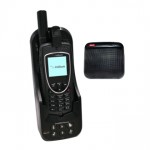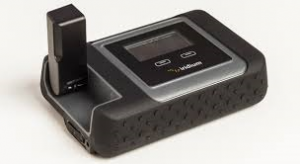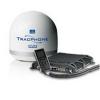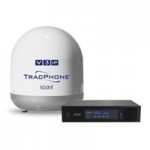While the Iridium GO! provides somewhat cheaper cost for transferring data, Iridium handsets can also be used to transfer data. Handsets also have an advantage in that they self-contained for voice calls in an emergency. The Iridium Extreme phone is water-resistant, incorporates a GPS, and has an “SOS” button that allows it to be used to summon help, as does the GO!. Some cruisers buy a “dock” like the one in the photo below from Beam. When in the dock the Extreme phone is connected to the external antenna, power, and to the computer/USB, and is kept charged. It can be quickly removed for manual use. Note that the Iridium GO! and Iridium handsets transfer data at about the same speed, but the Iridium GO! has cheaper data rates and connects more quickly.
 Iridium offers a “PPP Data Service” for their handsets, which is simpler and quicker than using the Iridium “Direct Internet Service” or a “Dialup” connection. This is a direct-to-internet connection through the Iridium internet gateway. The advantages are simplicity (no fancy compression or proxy-servers), no other internet service provider required, and faster setup. This service is perfect for checking mail with SailMail’s direct internet access (aka “Telnet”). This document describes how to set up an Iridium PPP connection.
Iridium offers a “PPP Data Service” for their handsets, which is simpler and quicker than using the Iridium “Direct Internet Service” or a “Dialup” connection. This is a direct-to-internet connection through the Iridium internet gateway. The advantages are simplicity (no fancy compression or proxy-servers), no other internet service provider required, and faster setup. This service is perfect for checking mail with SailMail’s direct internet access (aka “Telnet”). This document describes how to set up an Iridium PPP connection.
Drivers: USB drivers are needed for the Iridium 9555/9575 handsets, see this page for more info.
Also be aware that Windows-10 has been reported to “update” Iridium drivers with drivers that don’t work. If you encounter that, re-install the correct drivers.
Prior to using your Iridium phone for a PPP internet connection for the first time, you need to set up a “Standard 19200 bps” modem driver on your computer, and then set up a dial-up networking connection for the Iridium-PPP service. These steps are both described in detail below for Windows 7, 8 and 10:
First step: Install a Modem-Driver:
1. Close all applications (at least any that use the internet).
2. Open Windows Control Panel (Windows search box is your friend here).
3. Set “View by” to large or small icons, then double-click on “Phone and Modem Options”.
4. Select the “Modems” tab and click “Add”…
5. Check “Don’t detect my modem; I will select it from a list” and then click “Next”.
6. Select “Standard Modem Types”, then “Standard 19200 bps Modem” and then click “Next”.
7. Click the “Selected ports” button and highlight the COM Port that you will use with the Iridium phone (e.g., COM3). Click Next, then Finish.
8. Now go back to Control Panel, open “Device Manager”, find “Modems” and expand that, and find the “Standard 19200 bps Modem” that you just created. Double-click that to open “Properties”, and select the “Advanced” tab.
9. In the “Extra initialization commands” box, enter: AT+CBST=71,0,1
10. Double-check that, then click OK, then close Device Manager.
(Note: You can see the modem properties box via “Phone and Modems”, but the “Extra initialization commands” box is disabled. Go through Device Manager instead).
Second step: Configure a Dial-Up Networking connection
1. Open Windows Control Panel and select “Network and Sharing Center”.
2. Click “Set up a new connection or network” and then click Next.
3. Select “Connect to the Internet” and click Next.
4. If you see “You are already connected to the internet”, click on “Set up a new connection anyway”.
5. If you see “No, Create a new connection” select that, unless you are checking settings of an existing connection.
6. Click on “Dial-up”, and (if prompted) select “Standard 19200 bps Modem”.
7. In the “Dial-up phone number” box enter 008816000025 (see “Note” below)
For User name and Password enter “none” (type that in, without the quotes),
Check the “remember password” box.
For “Connection Name” enter “IridiumPPP”
8. Then click “Connect”, Windows will try to connect– click “Skip” to continue.
9. Click Close and return to Network Center.
10. Click “Change Adapter Settings” on the left, find “IridiumPPP” and right-click and select “Properties”. (Or, open the connection and then click the “Properties” button).
11. On the first tab make sure “Use dialing rules” is not checked, and click “Configure”
12. Then click “Configure”, and check all three hardware features, then click OK.
13. On the “Networking” tab, un-check all items except “Internet Protocol Version 4 (TCP/IPv4)”. (If any items won’t un-check, that is OK).
14. Click OK to close.
NOTE: Telstra customers should use the Telstra data number “66666”. The “0088…” number will also work but may be charged at a higher rate.
To connect manually, click on the Networks icon in the system-tray (lower-right corner of the screen), select “IridiumPPP” and select “Connect”. Repeat to disconnect. You can also get to the connections properties from this window.
The following details are important:
1. Don’t forget the “Extra initialization string” in the first section, this is critical.
2. Under Network Connections (second step), only “TCP/IP” should be checked.
3. You need the COM-port number associated with the phone. (The 9555 phone installs as a COM port, use the driver CD supplied with the phone).
4. You must be logged into Windows with Administrator privileges.
Once all that is done, open Airmail’s “Telnet” window (click the “Internet” button on the toolbar or open the Modules menu then Telnet-client). Check the “dial first” box in the Telnet window, and select the “Iridium PPP” connection, and make sure that the “hang up” box is also checked. In recent versions of Airmail the Telnet-window is already set up, just select “Server1”. Also be sure to select “Set up dedicated route”, this will block other programs from trying to “hijack” your Iridium connection.
To check mail, click Airmail’s “Internet” button (or go to Modules menu, Telnet-client), make sure “Server1” is selected, and click the green “connect” button. Airmail will dial the phone, contact the server, and exchange mail. Watch the connection and make sure it disconnects when finished. (in the rare case that the primary server is unavailable, there are also two backup servers available).
Troubleshooting:
Remember that the Iridium antenna must be outdoors, with a clear view of the sky. The best antenna is a proper fixed-mount Iridium marine antenna, they are not cheap but are strongly recommended if you are serious about it working reliably. The next-best is the small “hockey-puck” car-style antenna, IF it is stuck to a piece of metal (e.g. a car, or a metal pie-tin 8″/20cm or larger). It is meant to work on a car roof, and needs the metal ground-plane. The phone’s antenna also works (as a third choice), IF it is above-decks with a clear view and oriented vertically.
Also, remember that Iridium connections (voice or data) are relayed from satellite-to-satellite to reach an earth station. Your phone shows the signal strength to the first satellite only. If the next satellite is too far, or congested, then the connection can stall or be dropped.
- If the phone doesn’t connect at all, check the signal and then check the modem and connection settings above. Also verify that the phone display shows “Data call”.
- If the phone connects but you cannot connect to SailMail then check the Telnet settings below. You must be using port-50.
- If you do not have an Internet/Telnet window at all then go to Airmail’s Tools menu, Options window, Modules tab, and check the box to the left of “Telnet Client”. Click OK.
To check your Telnet settings first open the Telnet window (click the “Internet” button or go to Airmail’s Modules menu and select Internet or Telnet Client). Make sure “SailMail” is selected if you have also configured Airmail for ham use. Select “Server1” and click “Settings”. (From Airmail 3.5 these settings are part of the system settings, click Edit menu, then Settings. For earlier Airmail versions the settings may need to be entered manually).
Here are the correct settings (from mid-2020):
remote callsign: Server1 (or SMSG1)
remote host: 18.208.67.17 (see * note)
Port: 50
TImeout: (blank)
Local callsign: (your SailMail callsign/ID, see ** note)
Password: (your SailMail internet password, Case-Sensitive!).
Click OK to save settings.
* Note: Using the numeric IP address is strongly recommended, it saves airtime and is more secure. But remember that this address may change if we need to shift servers– so if you cannot connect then enter “server1.sailmail.com” and note the address which is shown when you connect. (Don’t include the quotes shown here). A second server is server2.sailmail.com with the address 44.232.19.175 both using port 50.
** Note: For Airmail 3.5 and later your Callsign/ID and password are entered in the Options window (Tools menu), Settings tab, on the left side under the small “Sailmail” tab).
And finally, if you want to initiate a PPP Data call manually for testing, click on Window’s Networking icon in the lower-right and select the “Iridium PPP” connection and click “Connect”. But don’t forget to disconnect when you are finished!
Cheers, Jim
support@sailmail.com
(revised 2021-06-14)





 Iridium offers a “PPP Data Service” for their handsets, which is simpler and quicker than using the Iridium “Direct Internet Service” or a “Dialup” connection. This is a direct-to-internet connection through the Iridium internet gateway. The advantages are simplicity (no fancy compression or proxy-servers), no other internet service provider required, and faster setup. This service is perfect for checking mail with SailMail’s direct internet access (aka “Telnet”). This document describes how to set up an Iridium PPP connection.
Iridium offers a “PPP Data Service” for their handsets, which is simpler and quicker than using the Iridium “Direct Internet Service” or a “Dialup” connection. This is a direct-to-internet connection through the Iridium internet gateway. The advantages are simplicity (no fancy compression or proxy-servers), no other internet service provider required, and faster setup. This service is perfect for checking mail with SailMail’s direct internet access (aka “Telnet”). This document describes how to set up an Iridium PPP connection.